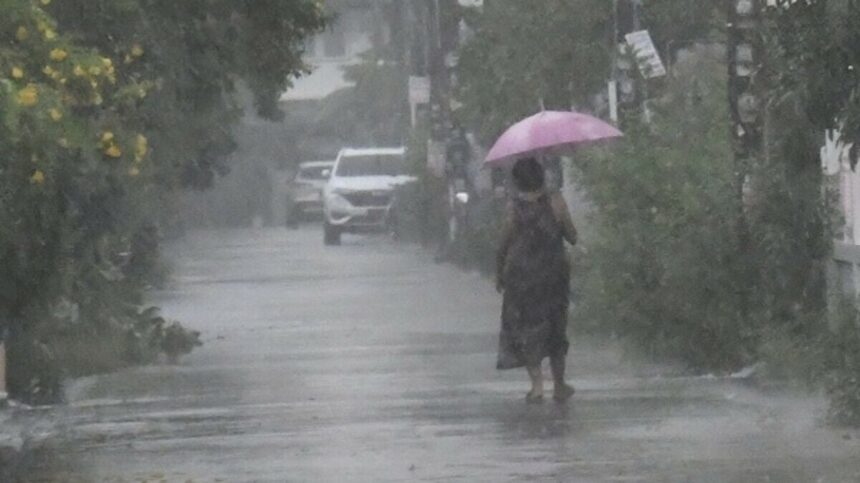CHIANG RAI – The Thai Meteorological Department (TMD) has issued an urgent weather alert, warning of heavy rain across northern Thailand. Flood risks are rising as rain continues in many areas.
The warning, which is in effect immediately, asks people living near hills, rivers, and low-lying spots to stay alert and prepare for worsening weather. Parts of Mae Sai, Chiang Rai, and Chiang Mai have already been hit by flooding, with local officials working hard to help people and protect buildings.
Intense Heavy Rain Hits North
A monsoon trough crossing northern Thailand, together with low pressure over the Andaman Sea, is bringing heavy rain to the region. The TMD says provinces like Chiang Mai, Chiang Rai, Lamphun, Lampang, and Phayao will see the heaviest rain until at least Thursday.
Dr Somchai Wattanaporn, a senior meteorologist at the Thai Meteorological Department TMD, explained: “We have several weather systems coming together, which means more heavy rain. People living near rivers or in low areas should keep an eye on water levels and listen to advice from local officials.”
In Mae Sai, Chiang Rai, flooding has already swept through homes, roads, and farms. The Sai River burst its banks after days of rain late on Monday, leaving parts of the town underwater and forcing families to leave their homes.
Local officials say at least 200 families have been affected, with water rising as high as one metre in places. “We’ve set up emergency shelters and are handing out food and water,” said Mae Sai District Chief Narongrit Srisuk. “The situation is still serious with more rain expected.”
Chiang Mai is also struggling with rising water levels. The Ping River, which flows through the city, is close to overflowing. Officials are strengthening riverbanks and installing pumps in areas like the Night Bazaar and Nawarat Bridge.
Businesses along the riverside have shut, and some residents have moved to safer ground. “I’ve never seen the river rise this quickly,” said Somporn Jittrakul, who runs a shop in Muang district. “We’re trying our best to save our homes, but it’s tough.”
Northeast and Central Regions Expect More Rain
The TMD has also warned of wet weather in the northeast and central Thailand, though conditions are not as severe as in the north. Provinces such as Nakhon Ratchasima, Udon Thani, and Khon Kaen are likely to get moderate to heavy rain as the monsoon moves east. No major flooding has been reported yet, but the TMD says water may build up in cities with poor drainage.
In central Thailand, including Bangkok, rain and storms are expected over the next two days. Bangkok is known to flood during the rainy season, so city officials are keeping a close watch.
The Bangkok Metropolitan Administration (BMA) is clearing drains and has set up mobile pumps in places like Sukhumvit and Lat Phrao. “We’re working with the TMD to track rainfall and respond quickly if there’s flooding,” said BMA spokesperson Ekachai Srisuwan. Still, heavy rain this morning caused traffic delays and waterlogged streets in several districts.
Communities and Officials on Alert
The TMD points out that flash floods and river overflows are a real risk, especially near hills and rivers. The landscape in the north can cause water to rush down into valleys and low areas quickly. The Department of Disaster Prevention and Mitigation (DDPM) has sent teams to help, handing out sandbags, pumps, and emergency kits. In Chiang Rai, rescue boats are helping people stranded by floodwater in Mae Sai and nearby villages.
Flooding in Mae Sai and Chiang Mai has hit local businesses, farming, and tourism. Many rice fields in Chiang Rai are underwater, putting crops at risk. In Chiang Mai, the tourism industry is facing another setback, with attractions closed and visitor numbers dropping because of the floods.
Weather Patterns and Ongoing Concerns
Meteorologists link the heavy rain to the monsoon season, plus wider changes in the climate. “We’re seeing more extreme rain events that are harder to predict,” said Dr Wattanaporn. “This matches what’s happening globally with climate change.” The TMD says the rainy season in the north, which usually lasts from May to October, has become more unpredictable, with sudden heavy rain putting pressure on systems built for lighter downpours.
The recent floods in Mae Sai and Chiang Mai highlight the need for better flood control. Experts have called for improved city planning, better drainage, and stronger rules on building near flood zones. “We should invest in things like flood barriers and better warning systems,” said Dr Anucha Setthasathien from Chiang Mai University. “If not, these floods will keep happening and the damage will only increase.”
Government Actions and Safety Advice
Prime Minister Srettha Thavisin has spoken about the floods, saying the government is watching the weather closely and is ready to help affected areas. “We’re supporting local officials and working to prevent more damage,” he said. Emergency funds have been set aside, and more aid is ready if conditions get worse.
People are urged to keep up with updates from the TMD and local news. The TMD advises against travel in flooded areas and recommends having enough food, water, and first aid supplies at home. Those at risk should move valuable items to higher places and have an evacuation plan ready.
As rain continues to fall in northern Thailand, communities are facing tough tests. The next few days will be important as teams work to control the flooding and protect people and property. For now, much of the region remains tense, with the sound of rain a steady reminder of what they’re up against.














